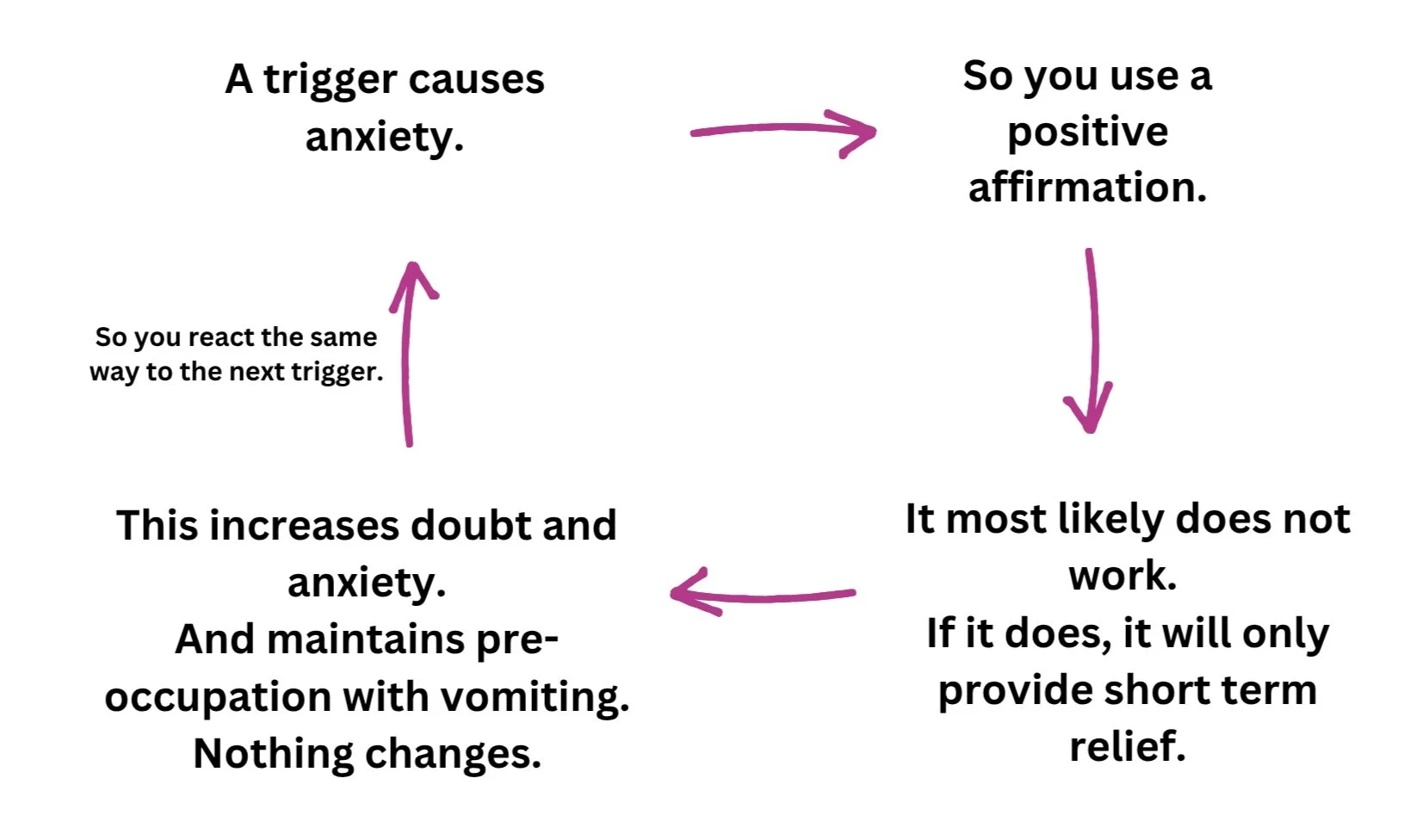Emetophobia: “Positive affirmations work! Positive affirmations work! Positive affirmations work!” …. Why repeating positive affirmations doesn’t work!
The internet is full of advice. Some of it good, most of it bad. The problem is telling them apart. Many online sources and even therapist suggest using positive affirmations. Positive affirmations are overly positive statements that you are instructed repeat to yourself, often daily or when triggered. Examples can include “Nothing will go wrong”, “Everything will be fine”, “I will not vomit” . “I am in full control” or “Today will be a good day”.
You may have even tried using them yourself. On the surface these phrases sound like nice things to say to yourself. However, they simply don't work and in the long term actually makes your anxiety problem worse. If they did work, you wouldn't be here reading this blog. You still have Emetophobia.
Don’t confuse positive affirmations with realistic thinking: There is a big difference between the positive affirmation of “I have full control over my vomiting” vs realistic thinking using facts such as “I have not vomited the last 20 times I felt this sensation in my stomach so its most likely going to be fine”.
So why don’t positive affirmations work:
Short term (if it even helps): For starters, even if positive affirmations were to work and make you feel better, it would only be a short-term solution. The next time you were triggered, you would have to repeat it again, and again, and again. Nothing changes.
Maintain pre-occupation: Some people have been told to repeat these types of affirmations throughout the day. However, each time you repeat the affirmation, you are just reminding yourself of the possibility of something going wrong (i.e. vomiting). This just increasing your awareness and pre-occupation with your fear.
Feels like a lie, fake or forced: Often overly positive statements feel forced. Our mind protests because it conflicts with what we really think, and the mind doesn't buy into something we don't really believe. The back of your mind will basically respond with some form of “but that isn't true!” or “but what if it does happen?”.
No behavioural change: When we use positive affirmations, we don't usually follow it up with positive actions. We often continue to use our safety behaviours. So, nothing really changes. Instead, we need to use realistic thinking and act based on fact, not our anxiety.
Doubt: Positive affirmations can increase doubt, making us feel more uneasy about the subject the affirmations are trying to help with.
This cycle shows how that if we were to try and use positive self talk or affirmations in response to a trigger, it only backfires and causes more problems. Even if it does help reduce your anxiety, it would only be a short term solution.
This cycle shows what occurs when if you were to repeat positive affirmations as a part of your routine. The act of doing so, causes you to think of the fear you are trying to prevent. This increases your pre-occupation, fear and doubt about it. Which raises your anxiety, prompting you to try more affirmations.
Don’t just take my word for it:
This is a testable idea. Pick some positive affirmations, then try repeating them to yourself every other day for a week or two in the morning and in response to anxiety. One day use them, the next day don’t. Keep doing this and test out if they work. If they work, then you should have a reduction in your anxiety. If they don’t work, you will see either no change, or even an increase in your anxiety.
So, what should I use instead of positive affirmations:
No one can guarantee that everything will be fine. That's why positive affirmations don't work. They don't feel believable. That's why realistic thinking is needed.
When you are faced with a worry you need remind yourself of what is the true level of risk compared to what anxiety is trying to get you to think. Your anxiety is trying to get you think the worst. This causes you to act as if the likelihood of your fear is more likely than it is. When you think this, it is natural to want to prevent your fear by using safety behaviours, checking or getting reassurance.
Instead, you need to consider the true likelihood of your fear occurring and then act on that. You need to accept and tolerate some level of risk. Do nothing in response to your anxiety and see what happens.
Therapy:
Emetophobia is treatable. I recommend reaching out to a BABCP accredited CBT therapist or self-referring yourself to the NHS talking therapies services which can offer Emetophobia support.
Written by David Kaneria - CBT Therapist



